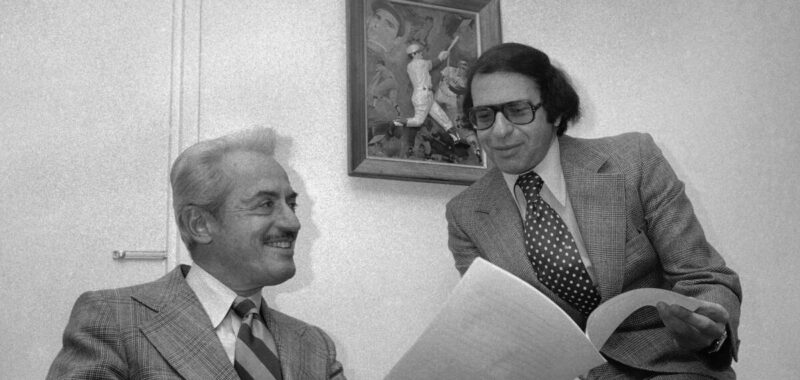Dick Moss, who earned the trust of powerful union chief Marvin Miller when they represented the United Steelworkers of America, and then proved that trust was well-placed by winning the arbitration case that created free agency for Major League Baseball players almost 50 years ago, has died. He was 93.
The 1975 case involved Dodgers pitcher Andy Messersmith and prompted arbitrator Peter Seitz to strike down the reserve clause, the restrictive contract language that had kept players under perpetual team control for nearly 100 years. Seitz was swayed by the arguments of Moss and narrowed the definition of the clause, determining it meant only a one-year renewal, a decision that led to collectively bargained free agency.
Baseball appealed the ruling, but it was upheld in federal court in 1976 with Moss arguing for the players. Later that year, free-agency rules were the foundation of a collective bargaining agreement between MLB and the players’ union.
“The difference between winning and losing can be stated in billions and billions of dollars,” Moss said at a party at his Pacific Palisades home to celebrate the 25th anniversary of the ruling. “I don’t think you can find another labor-arbitration case that can say that.”
Moss died Saturday at an assisted-living facility in Santa Monica, according to his niece, Nina Wiener. Although he was born and raised near Pittsburgh, he spent much of his adult life in the Los Angeles area.
Richard Myron Moss was born on July 30, 1931, to Nathan and Celia (Rosenblatt) Moss. He earned a bachelor’s degree from the University of Pittsburgh in 1952 and a law degree from Harvard in 1955 before serving in the Army for two years.
He worked for the Pennsylvania state government before catching on with the steelworkers union in 1960, where he met Miller, who would become his mentor. Six years later, Miller became the first executive director of the MLB Players Assn. and he brought Moss with him.
The two lawyers soon began educating players on union strategies. They hammered out baseball’s first collective-bargaining agreement in 1968 and had negotiated an arbitration system by 1970.
“Working in tandem was exactly what built the solid foundation,” former pitcher Steve Rogers, a Moss client and longtime union official, told the Associated Press. “None of what is happening today exists without the solid foundation.”
Moss became acquainted with outfielder Curt Flood, who challenged the reserve clause in federal court after refusing to report to the Philadelphia Phillies when the St. Louis Cardinals traded him in 1969. Although Flood lost his case at the U.S. Supreme Court, the inherent unfairness of players being prevented from signing with the highest bidder became apparent.
The New York Yankees emerged as the franchise most willing to pay players previously unheard-of salaries, inadvertently helping the efforts of Miller and Moss.
First came the case of pitcher Catfish Hunter, whom the Yankees signed to a five-year, $3.25-million deal in 1974 after Moss asserted that Hunter’s existing one-year, $100,000 contract with the Oakland Athletics was invalid because of a dispute over a deferred insurance annuity. Moss pointed to Hunter’s Yankees contract as proof that in an open market players would make far more than they did with the reserve clause in effect.
Then came the cases of pitchers Messersmith and Dave McNally, who refused to sign what they deemed substandard contracts for the 1975 season.
Their teams responded by renewing their deals on the 1974 terms, which in Messersmith’s case was for $90,000 and exceedingly unfair. The right-hander had led the Dodgers to the 1974 World Series and finished second in National League Cy Young Award voting after leading the league with 20 wins while posting an earned-run average of 2.59 over 292 innings.
Playing without a signed contract in 1975, Messersmith had another outstanding season, leading the NL with 19 complete games, seven shutouts and 321 innings while posting a 19-14 record and 2.29 ERA.
Moss represented Messersmith and McNally — who also had pitched without a contract in 1975 — in asserting that a player should become a free agent one year after the expiration of his contract. After this so-called “option year,” Moss argued, a player should be allowed to peddle his services to the highest bidder.
Moss argued the case to Seitz, who ruled that teams had “no right or power” to retain the services of Messersmith and McNally beyond the renewal year that had already been fulfilled. The ruling was upheld by the U.S. Court of Appeals and free-agency rules were introduced in a collective-bargaining agreement in 1976.
A year later, Moss left the union to become an agent, and he eventually represented Dodgers pitching phenom Fernando Valenzuela as well as future Hall of Famers Nolan Ryan, Gary Carter and Jack Morris.
After Ryan’s three-year, $600,000 contract with the Angels expired after the 1979 season, Moss negotiated a four-year, $4.5-million deal with the Houston Astros, making Ryan the first MLB player to be paid a million a year. Moss also argued the cases with the Dodgers that got Valenzuela the first $1-million salary through arbitration in 1983 and made him baseball’s highest-paid pitcher with a three-year, $5.5-million deal by avoiding arbitration in 1986.
Moss is survived by his third wife, Carol Freis, whom he married in 1980, and a daughter from his second marriage, Nancy Moss Ephron. Another daughter from his second marriage, Betsy, predeceased him.
The Associated Press contributed to this report.

